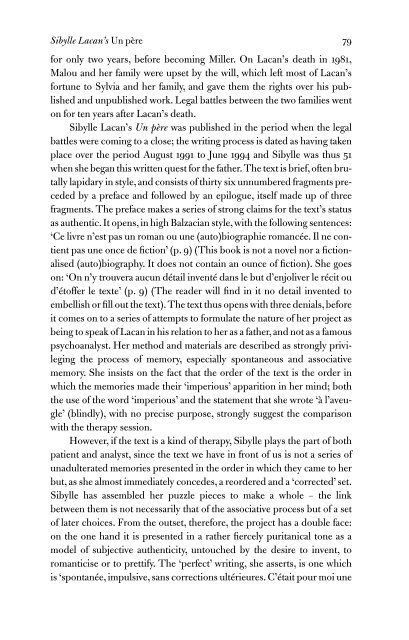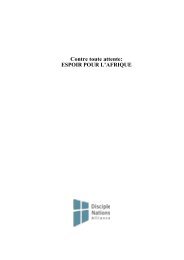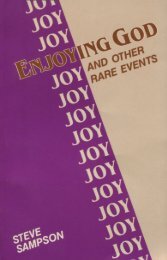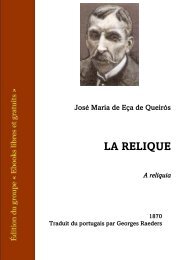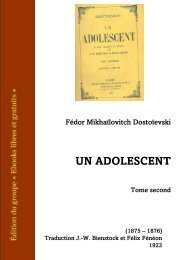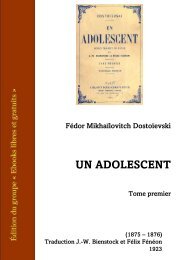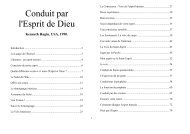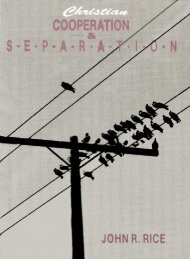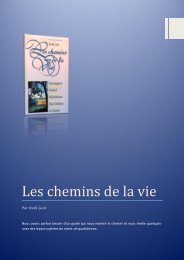Women writing in contemporary France
Create successful ePaper yourself
Turn your PDF publications into a flip-book with our unique Google optimized e-Paper software.
Sibylle Lacan’s Un père 79<br />
for only two years, before becom<strong>in</strong>g Miller. On Lacan’s death <strong>in</strong> 1981,<br />
Malou and her family were upset by the will, which left most of Lacan’s<br />
fortune to Sylvia and her family, and gave them the rights over his published<br />
and unpublished work. Legal battles between the two families went<br />
on for ten years after Lacan’s death.<br />
Sibylle Lacan’s Un père was published <strong>in</strong> the period when the legal<br />
battles were com<strong>in</strong>g to a close; the <strong>writ<strong>in</strong>g</strong> process is dated as hav<strong>in</strong>g taken<br />
place over the period August 1991 to June 1994 and Sibylle was thus 51<br />
when she began this written quest for the father. The text is brief, often brutally<br />
lapidary <strong>in</strong> style, and consists of thirty six unnumbered fragments preceded<br />
by a preface and followed by an epilogue, itself made up of three<br />
fragments. The preface makes a series of strong claims for the text’s status<br />
as authentic. It opens, <strong>in</strong> high Balzacian style, with the follow<strong>in</strong>g sentences:<br />
‘Ce livre n’est pas un roman ou une (auto)biographie romancée. Il ne contient<br />
pas une once de fiction’ (p. 9) (This book is not a novel nor a fictionalised<br />
(auto)biography. It does not conta<strong>in</strong> an ounce of fiction). She goes<br />
on: ‘On n’y trouvera aucun détail <strong>in</strong>venté dans le but d’enjoliver le récit ou<br />
d’étoffer le texte’ (p. 9) (The reader will f<strong>in</strong>d <strong>in</strong> it no detail <strong>in</strong>vented to<br />
embellish or fill out the text). The text thus opens with three denials, before<br />
it comes on to a series of attempts to formulate the nature of her project as<br />
be<strong>in</strong>g to speak of Lacan <strong>in</strong> his relation to her as a father, and not as a famous<br />
psychoanalyst. Her method and materials are described as strongly privileg<strong>in</strong>g<br />
the process of memory, especially spontaneous and associative<br />
memory. She <strong>in</strong>sists on the fact that the order of the text is the order <strong>in</strong><br />
which the memories made their ‘imperious’ apparition <strong>in</strong> her m<strong>in</strong>d; both<br />
the use of the word ‘imperious’ and the statement that she wrote ‘à l’aveugle’<br />
(bl<strong>in</strong>dly), with no precise purpose, strongly suggest the comparison<br />
with the therapy session.<br />
However, if the text is a k<strong>in</strong>d of therapy, Sibylle plays the part of both<br />
patient and analyst, s<strong>in</strong>ce the text we have <strong>in</strong> front of us is not a series of<br />
unadulterated memories presented <strong>in</strong> the order <strong>in</strong> which they came to her<br />
but, as she almost immediately concedes, a reordered and a ‘corrected’ set.<br />
Sibylle has assembled her puzzle pieces to make a whole – the l<strong>in</strong>k<br />
between them is not necessarily that of the associative process but of a set<br />
of later choices. From the outset, therefore, the project has a double face:<br />
on the one hand it is presented <strong>in</strong> a rather fiercely puritanical tone as a<br />
model of subjective authenticity, untouched by the desire to <strong>in</strong>vent, to<br />
romanticise or to prettify. The ‘perfect’ <strong>writ<strong>in</strong>g</strong>, she asserts, is one which<br />
is ‘spontanée, impulsive, sans corrections ultérieures. C’était pour moi une


